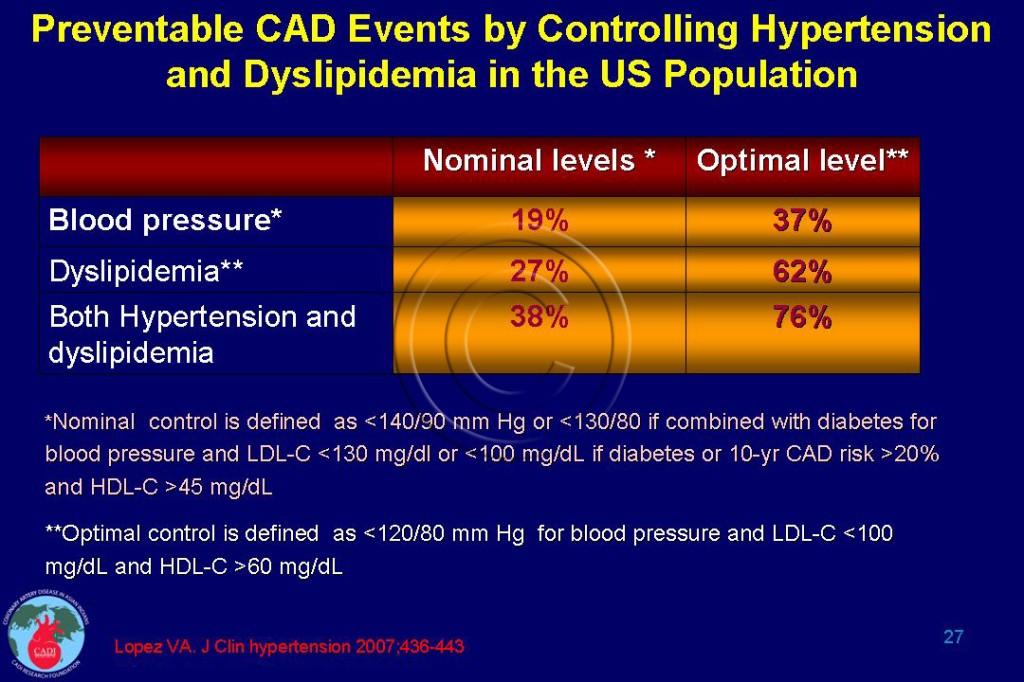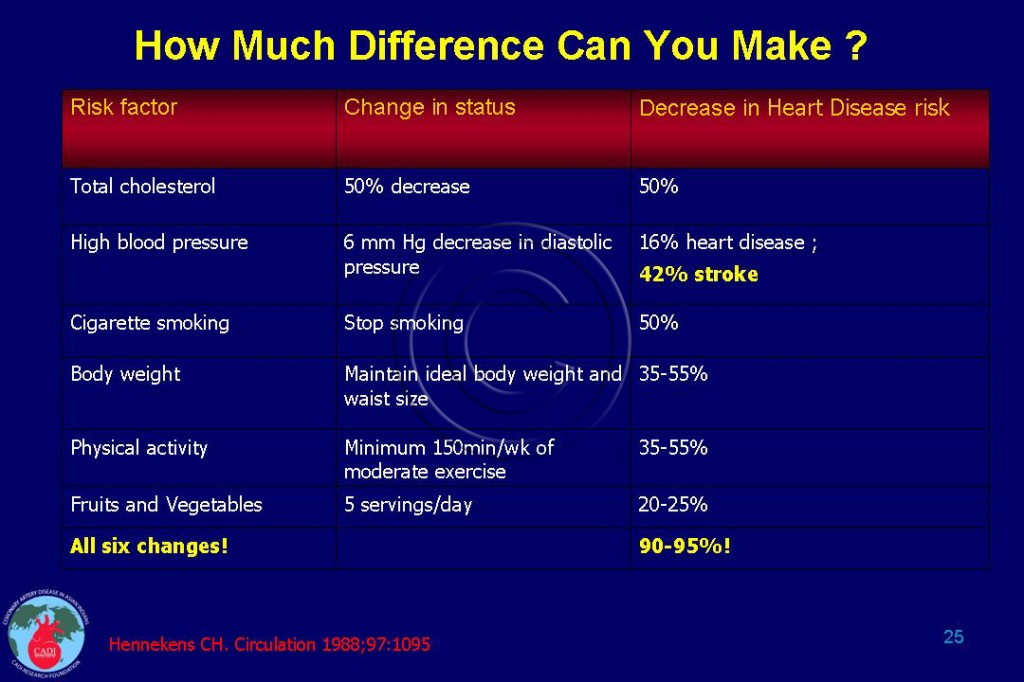Prevention Overview
- Over the past 30 years, heart disease has decreased by 50% to 80% in many high-income countries such as US, UK and Finland.1-7 In sharp contrast, heart disease has increased dramatically in many low-income and-middle-income countries (LMIC) especially India. 1-4
- Primary prevention accounts for substantially larger reductions in CAD-related mortality (79%) than secondary prevention (21%).8
- The dramatic decrease in heart disease occurred despite escalating epidemics of obesity and diabetes that are sweeping the entire world and are attributed to decrease in cholesterol, blood pressure, and smoking. These observations suggest that controlling these three risk factors will have direct and substantial effect on CVD (cardiovascular disease), while obesity may be increasing.1
- Combined control of blood pressure (BP) and lipid levels may prevent the majority of CAD (coronary artery disease) events in Americans.9 It is estimated that in the US population, CAD risk can be reduced by 19% by lowering the blood pressure to <140/90 and by 37% by lowering the blood pressure to <120/80.9
- An even greater reduction can be achieved by aggressively treating dyslipidemia (cholesterol abnormalities). CAD events are reduced by 27% by lowering the LDL to <100 mg/dl and by 62% if HDL cholesterol is also raised to >60 mg/dl. Combined control of BP and lipids to optimal levels would prevent CAD events by 76%.9 Table 027.
- Adding cessation of cigarette use, maintaining optimal body weight, exercising regularly, and eating a healthy diet can reduce the risk of heart disease by 90-95% (Table 025).10
- The INTERHEART and INTERSTROKE studies showed that, in all regions of the world, both CAD and stroke share many of the same risk factors, including smoking, obesity, hypertension, dyslipidemia, diabetes, low consumption of fruits and vegetables, and physical inactivity.11, 12
- Health education alone will have little impact on the epidemic because smoking, sedentariness, and poor diet do not arise in a vacuum but are determined to a great extent by social forces that act at the local, national, and international levels and that are strongly linked to social and economic development, urbanization, education, and income.13 14
Prevention Principles and Classification
Global Success in CVD Prevention
Population Based Prevention and Success
Reduce Glycemic Loadand Glycemic Load
Sources
1. Anand SS, Yusuf S. Stemming the global tsunami of cardiovascular disease. Lancet. Feb 12 2011;377(9765):529-532.
2. Capewell S, Morrison CE, McMurray JJ. Contribution of modern cardiovascular treatment and risk factor changes to the decline in coronary heart disease mortality in Scotland between 1975 and 1994. Heart. 1999;81(4):380-386.
3. Ford ES, Ajani UA, Croft JB, et al. Explaining the decrease in U.S. deaths from coronary disease, 1980-2000. N Engl J Med. Jun 7 2007;356(23):2388-2398.
4. Unal B, Critchley JA, Capewell S. Explaining the decline in coronary heart disease mortality in England and Wales between 1981 and 2000. Circulation. Mar 9 2004;109(9):1101-1107.
5. O’Flaherty M, Ford E, Allender S, Scarborough P, Capewell S. Coronary heart disease trends in England and Wales from 1984 to 2004: concealed levelling of mortality rates among young adults. Heart. Feb 2008;94(2):178-181.
6. Ford ES, Capewell S. Coronary heart disease mortality among young adults in the U.S. from 1980 through 2002: concealed leveling of mortality rates. J Am Coll Cardiol. Nov 27 2007;50(22):2128-2132.
7. O’Flaherty M, Bishop J, Redpath A, et al. Coronary heart disease mortality among young adults in Scotland in relation to social inequalities: time trend study. BMJ. 2009;339:b2613.
8. Young F, Capewell S, Ford ES, Critchley JA. Coronary mortality declines in the U.S. between 1980 and 2000 quantifying the contributions from primary and secondary prevention. Am J Prev Med. Sep 2010;39(3):228-234.
9. Lopez V A, Franklin SS, Tang S, Wong ND. Coronary heart disease events preventable by control of blood pressure and lipids in US adults with hypertension. J Clin Hypertens (Greenwich). Jun 2007;9(6):436-443.
10. Enas EA. How to Beat the Heart Disease Epidemic among South Asians: A Prevention and Management Guide for Asian Indians and their Doctors. Downers Grove: Advanced Heart Lipid Clinic USA; 2011.
11. O’Donnell M. J., Xavier D, Liu L, et al. Risk factors for ischaemic and intracerebral haemorrhagic stroke in 22 countries (the INTERSTROKE study): a case-control study. Lancet. Jul 10 2010;376(9735):112-123.
12. Yusuf S, Hawken S, Ounpuu S, et al. Effect of potentially modifiable risk factors associated with myocardial infarction in 52 countries (the INTERHEART study): case-control study. Lancet. Sep 11 2004;364(9438):937-952.
13. Marmot M, Friel S, Bell R, Houweling TA, Taylor S. Closing the gap in a generation: health equity through action on the social determinants of health. Lancet. Nov 8 2008;372(9650):1661-1669.
14. Paradis G, Chiolero A. The cardiovascular and chronic diseases epidemic in low- and middle-income countries a global health challenge. J Am Coll Cardiol. Apr 26 2011;57(17):1775-1777.



